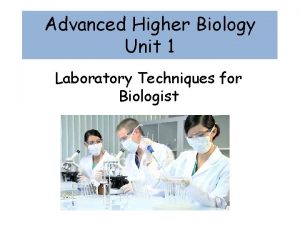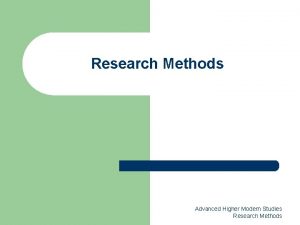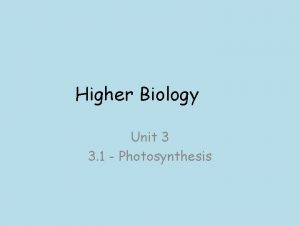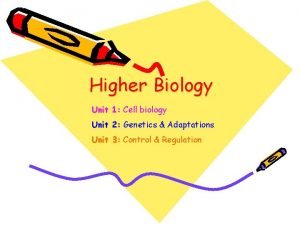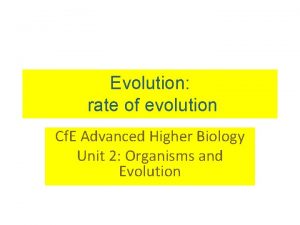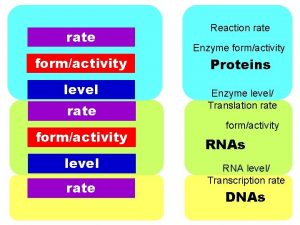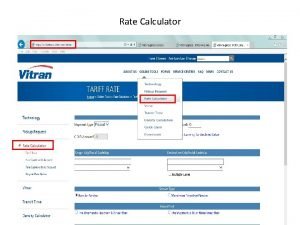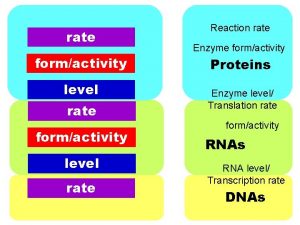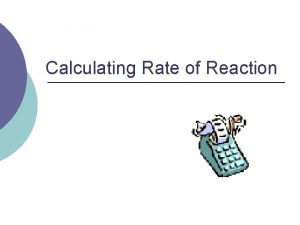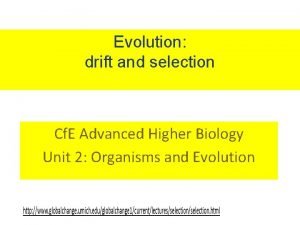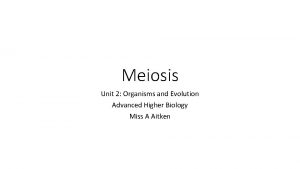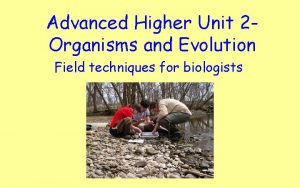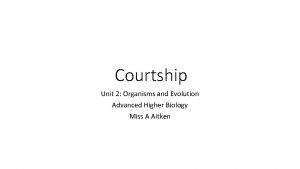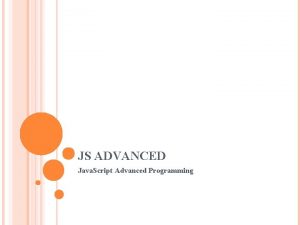Evolution rate of evolution Cf E Advanced Higher




























- Slides: 28

Evolution: rate of evolution Cf. E Advanced Higher Biology Unit 2: Organisms and Evolution

Unit 2 - Organisms a) Drift and Selection b) Rate of evolution c) Co-evolution and the Red Queen Hypothesis

Starter- think back to previous learning…. Write the definitions these terms: • • • Independent variable Pilot study Absolute fitness Relative fitness Latency Anthropomorphism

b) Rate of Evolution Key areas • Identify factors that can effect the rate of evolution. • Explain the role of selection pressures in increasing the rate of evolution. • Use and compare cladograms in evolution rate. • Define transformation, conjunction and transduction. • Define horizontal gene transfer. • Identify the effect of horizontal gene transfer and sexual reproduction on beneficial genes.

• Evolutioninfo We know how evolution takes place and the processes that advance it. • The relationships between common ancestors can be followed using the classification system below and phylogenic diagrams know as cladograms. • • A cladogram can be described as a branching treelike diagram used to illustrate evolutionary (phylogenetic) relationships among organisms. At each point of divergence, there are two branching lines of descendance, indicating evolutionary divergence from a common ancestor.

Human & Primate Evolution Domain Eukaryota Kingdom Animalia Phylum Chordata Class Mammalia Order Primates Suborder Haplorhini Family Hominidae Genus Homo Species H. sapiens http: //www. columbia. edu/itc/eeeb/cords/primates/diversity. html

Evolutionary Comparison • What effect does generation time have on evolution of organisms? • What would be different between primates and MRSA?

Selection pressure • Thinking back to natural selection. • What is meant by selection pressure in evolution? • Selection pressure can be defined as any factor in the internal or external environment that reduces the reproductive success of a population and influences the frequency of traits in a population. • It is the driving force behind natural selection. • What factors could do this?

Rate of evolution • Some of the main factors which can increase the rate of evolution include: § Shorter generation times- Bacteria, viruses § Warmer environments- effect of global warming § Sharing of beneficial DNA sequences between different lineages through sexual reproduction and horizontal gene transfer. • When selection pressures are high, the rate of evolution can be rapid.

Rate of Evolution - Key Concepts • Where selection pressures are high, the rate of evolution can be rapid. • The rate of evolution can be increased by factors such as shorter generation times, warmer environments and the sharing of beneficial DNA sequences. • This can be achieved between different lineages through sexual reproduction and horizontal gene transfer.

Shorter generation times • How can this affect the rate of evolution? Use the examples below • • If generation time is shorter then more generations can occur in a set period of time. With each cycle of reproduction DNA replication occurs. Mutations occur during meiosis and DNA replication. This would lead to an increased rate of mutation which in turn would speed up the rate of evolution. e. g. MRSA antibiotic resistanc e in bacteria e. g. Insect resistan ce to use of pesticide s

Warmer Climates • The mean global surface temperature has increased by about 0. 5° to 0. 7°C since the late 19 th century, and by about 0. 3° to 0. 4°C over the last 40 years.

Warmer climates- effect on the rate of evolution • The increase in global temperatures is a selection pressure for organisms. • Heat tolerant individuals will have an advantage and are more likely to survive, reproduce and pass on the genes for heat tolerance. • Over many generations, this process produces a population with adaptations well-suited for the hotter environment. • Populations with a greater number of genetic variants in it, will have a greater capacity to evolve when faced with a changing environment. • Why?

Example- European great tit • European great tits are different breeding times. evolving • With increased temperatures recent caterpillars have been maturing earlier in the spring. • The birds that are able to adjust egglaying to earlier in the spring can time hatching so that it coincides with greater caterpillar abundance. • Birds with genes for more flexible egglaying times are more successful than birds with less flexibility in their egglaying.

Example - Field mustard (Brassica rapa) • Field mustard has also evolved in response to global warming. • Drought conditions in southern California over the last decade or so has been the main selection pressure. • These plants flower and produce seeds near the end of the rainy season but when the rainy season is cut short by a drought, late blooming plants wither and die before they can produce seeds. • This form of natural selection favours early bloomers. • Research has found that post-drought plants had evolved to flower up to 10 days earlier.

Sharing beneficial DNA sequences • The sharing of beneficial DNA sequences through sexual reproduction creates increases variation in a population, which gives sexually reproducing organisms the advantage over asexually reproducing organisms. • Horizontal gene transfer has played a major role in the evolution of bacteria. • Horizontal gene transfer has several mechanisms but it always involves the transfer of genetic material (DNA/RNA) between organisms. • It often involves the use of plasmids. Barth F. Smets, Ph. D. , with permission

Horizontal gene transfer There are 3 main mechanisms: § Transformation § Transduction § Conjugation

Transformation • This involves the genetic alteration of a prokaryotic cell (e. g. bacteria) due to the uptake and successful expression of foreign DNA or RNA. (eg, bacteria) • The foreign allele that is taken up by the cell replaces the cell’s existing allele for a particular characteristic. • Many bacteria have cell-surface proteins that recognise DNA from closely related species and transport it into the cell. • Once inside the cell, the foreign DNA can be incorporated into the genome by homologous DNA exchange. (transfer between chromosomes)

Transduction • Transduction is the process by which DNA is transferred from one bacterium to another by a virus. • The main steps to the process are: 1. Bacteriophage infects bacterial cell. 2. Host cell DNA is fragmented, phage DNA and proteins are made, this is the donor cell. 3. Bacterial DNA fragment ( blue) may be packaged in a phage capsid instead of phage DNA (purple). 4. Phage with bacterial DNA infects a recipient bacterial cell. 5. Recombination occurs between donor DNA and recipient DNA. 6. The genotype of the recombinant cell is different to the donor cell and the original recipient.

Transduction


Conjugation • Bacterial conjugation involves the transfer of genetic material through cell-cell contact. DNA transfer is one-way only. 1. The donor cell uses pili to attach to the recipient. 2. The donor cell, containing an F plasmid (F+ ‘male’) forms a bridge with the recipient cell. (F-’female’) 3. A single strand of the donor F-plasmid moves into the recipient cell. DNA replication then begins. 4. DNA replication takes place in both the donor and the recipient cells. Both the donor and the recipient cell now contain a complete F-plasmid. Genetic transfer has taken place and the recipient cell is now a recombinant.

Past paper questions



• Discuss the process of evolution under the following headings: • (i) importance of mutation in enabling evolution; 6 • (ii) factors increasing the rate of evolution. 4

• 1. evolution is the change in genetic composition of population over time • 2. mutation gives rise to new sequences of DNA/novel alleles • 3. results in new variants/variation in traits/new phenotypes • 4. mutation can be harmful, neutral or beneficial • 5. beneficial mutations increases ‘fitness’ • 6. individuals compete for limited resources… • 7. …individuals with favourable alleles more likely to survive and breed • 8. these (favoured) alleles become more frequent in subsequent generations • 9. definition of fitness in relation to fecundity Max 6

10. high selection pressure 11. shorter generation time 12. warmer environments 13. sharing of beneficial DNA sequences between lineages • 14. / 15 eg of how… • • • Through sexual reproduction OR • horizontal gene transfer (as in X-bacteria)
 Understanding standards pe
Understanding standards pe Ah geography understanding standards
Ah geography understanding standards Higher art expressive
Higher art expressive Advanced higher computing science
Advanced higher computing science Ahmaths
Ahmaths Advanced higher physics formula sheet
Advanced higher physics formula sheet Higher graphic communication
Higher graphic communication Advanced higher english dissertation examples
Advanced higher english dissertation examples Higher biology unit 3
Higher biology unit 3 Advanced higher music concepts
Advanced higher music concepts Advanced higher mechanics
Advanced higher mechanics Understanding standards higher english
Understanding standards higher english Advanced higher modern studies understanding standards
Advanced higher modern studies understanding standards Higher biology essay questions and answers
Higher biology essay questions and answers Advanced higher history
Advanced higher history Advanced higher history dissertation examples
Advanced higher history dissertation examples Higher english techniques
Higher english techniques Higher modern studies understanding standards
Higher modern studies understanding standards Sqa higher english understanding standards
Sqa higher english understanding standards Uncertainties higher physics
Uncertainties higher physics Unit 3 higher biology questions
Unit 3 higher biology questions Advanced higher textual analysis
Advanced higher textual analysis Line of best fit in physics
Line of best fit in physics Higher modern studies essay introduction examples
Higher modern studies essay introduction examples Advanced higher art
Advanced higher art Higher biology unit 2 past paper questions
Higher biology unit 2 past paper questions Sex determination and sex linkage
Sex determination and sex linkage Advanced higher biology
Advanced higher biology Orthogonal frequency division multiplexing
Orthogonal frequency division multiplexing








